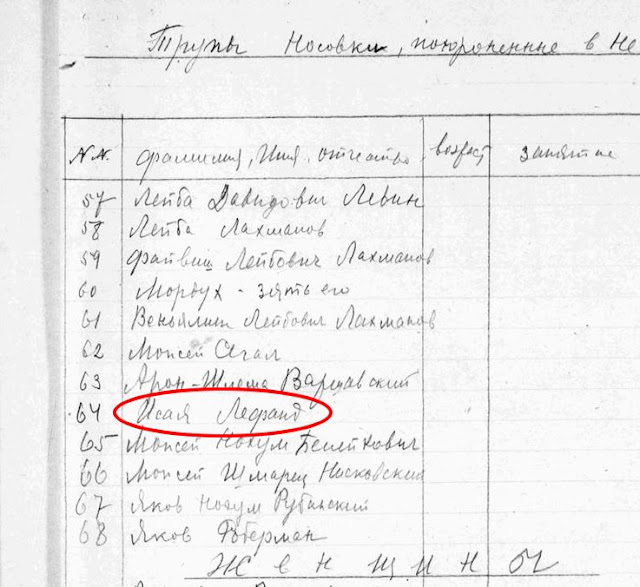I have a scheduled research appointment at the US Holocaust Memorial Museum (USHMM), and I've been preparing for what I'll want to see while I'm there. But one thing I've noticed is that not all USHMM research needs to be done in person, as there are documents that are scanned and available remotely from the comfort of your home. And it's also important to note that not all collections housed by USHMM are Holocaust-related--some documents that the museum has are from events that took place well before the Holocaust.
Below I'll show an example of a document found that mentions one of my relatives in 1919, and then I'll explain how you can see if there are documents relating to your ancestral town or relatives.
 |
| List of 1919 Pogrom Victims for Nezhin; Derz︠h︡avnyĭ arkhiv Kyïvsʹkoï oblasti via US Holocaust Museum Memorial |
In searching for collections related to my ancestral town of Nezhin, I came across a reference to a collection of documents listing victims of the pogroms of 1919 in Nezhin. (In fact, the lists include victims from the entire Nezhin district, and pogroms in 1918 and 1920 as well.) Obviously these lists were created well before the Holocaust.
This collection contained multiple lists, some in Russian and others in Yiddish. Some names popped up on multiple lists, while others appeared only once. There were some entries with full names (some including patronymics--the victim's father's name), others were just relationships ("Avraham Kravky’s wife"), and some listed the person by profession ("Zelig the Shoemaker"). Then there were people listed like "Mendel the Crazy" (Mendel der meshuganner), and others with no more information than "a child."
Within the lists, I discovered that my second cousin twice removed, Yeshaya Lefand, was murdered in a 1919 pogrom in the town of Nosovka, in Nezhin district. (His name appears on three lists, all in Russian.)
So how do you find out if there are documents that might be of interest to your personal interest? I'll walk you through how I discovered this document.
- Start at https://collections.ushmm.org/search/
- In the search entry, try searching for your town(s) of interest--using all possible spellings and versions of that town name. Also search for your surnames of interest, also using spelling variations.
- As a sub-note, also search in foreign languages that might be used. In many cases, the search engines will still find documents, but in others it does not. You wouldn't want to miss potential documents because a finding aid was only written in a foreign language.
- Look at the results and click on any that might be of interest.
You'll see one of a few variations....
 |
| Some collections require an in-person visit |
But some collections are viewable from home.
 |
| Some collections are available from home |
If a collection is "Available for Research," well, then you can view the documents from the comfort of your own home. Most such collections (and many of the ones that require an in-person visit) have finding aids that can help you navigate what records it includes--and you can search for the search term you had used to locate the relevant documents. So here's how I found these Nezhin records. A search led me to a collection called "Jewish pogroms in Ukraine, 1918-1924. Documents of the Kiev Oblast’ Commission for Relief to Victims of Pogroms (Obshetskom) (Fond 3050)." I saw that the collection was available for research, and there was also a link to a Finding Aid--and it was in English (not all are in English).
 |
| Look at the Finding Aids! |
This Finding Aid is a 45-page PDF. Once I open it, I can CTRL-F and search for Nezhin. There are actually several entries, and I can page through them and find this:
I see that I'm interested in Case 220, and on the left, I can select Case 220, which when I scroll up I can see is on Reel 16. When I open up Reel 16 on the left, I can see it starts at Case 208. So I can scroll through the film until I see Case 220--and there are the documents I'm looking for, lists of names.
 |
| Film 16 starts at case 208. I need to scroll using the arrows above the image until I see 220. |
This is only one example--hopefully you can find others. And since USHMM is continually digitizing documents and adding them online, if you don't find anything now, keep checking back. And if you do find something, also keep checking back for even more.
And stay tuned; after my in-person visit, I'll make sure to update about how it went.
Shana tova, all!
You can like my page on Facebook:
or follow @larasgenealogy on Twitter.


Thanks for this tutorial, Lara. This is a great example of, "thinking outside of the box!" I appreciate the tip. 'Happy Hunting' . . . and good luck on your visit. I'll look forward to the follow-up report.
ReplyDeleteThanks, Lara, this is a great reminder to dig a little further. I hope your research trip went well!
ReplyDelete